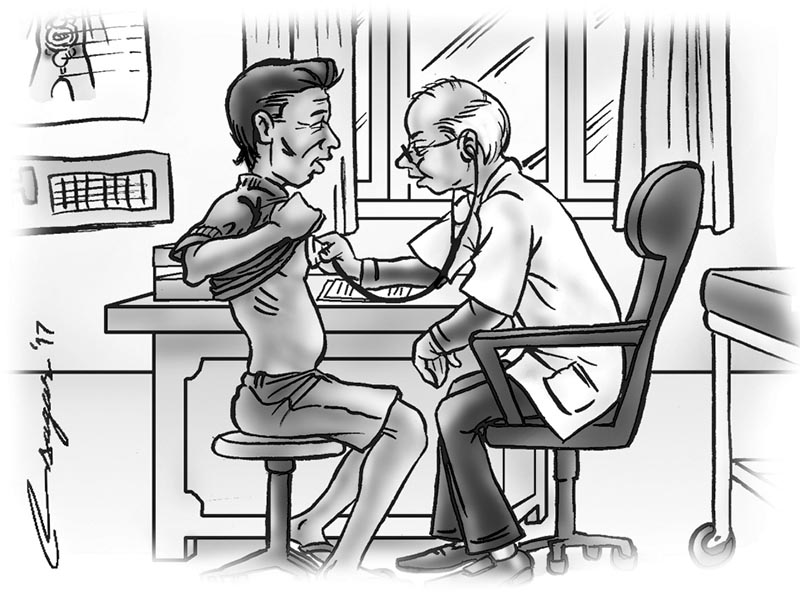2016 Nepal Demographic Health Survey launched
Kathmandu, November 13
2016 Nepal Demographic and Health Survey was launched at a programme organised by the Ministry of Health in the Capital.
The findings of the survey provide up-to-date estimates of fertility levels and preferences, marriage, sexual activity, nutrition, breast feeding practices, anaemia, childhood and maternal mortality, maternal and child health, HIV/AIDS and other sexually transmitted infections and domestic violence.
For the first time, the NDHS included findings on hypertension.
The findings of the survey highlight major progress over the last 20 years in maternal and child health. The 2016 NDHS findings reveal that more children in Nepal are surviving early childhood than ever before with a sharp decline in under-five mortality from 118 deaths per 1,000 live births in 1996 to 39 deaths per 1,000 live births in 2016. Infant mortality has decreased from 78 per 1,000 live births to 32 in the same years.
Similarly, the nutritional status of children in Nepal has improved since 1996. The survey measured children’s nutritional status by comparing height and weight. More than half, 57 per cent children under five were stunted in 1996 compared to 36 per cent in 2016. In addition, 27 per cent children are underweight while the rate was 42 per cent in 1996.
In addition, the data reveals that currently women in Nepal have an average of 2.3 children. The fertility has decreased from 4.6 children per woman to the current level. Fertility is lowest in Province-3 (1.8 children per woman) and highest in Province-2 (3 children per woman).
The findings also reveal that the use of any method of family planning by married women has nearly doubled from 29 per cent in 1996 to 53 per cent in 2016. Similarly, modern method use has increased from 26 per cent to 43 per cent during the same time period but hasn’t changed since 2006.
The findings also reveal that more than 8 out of 10 women (84 per cent) aged 15 to 49 receive antenatal care from a skilled provider — doctor, nurse and auxiliary nurse midwife. Overall 58 per cent births are assisted by a skilled provider, the majority by doctors. One out of ten births is assisted by no one.
The 2016 NDHS data show that 57 per cent births are delivered in a health facility, a dramatic increase from 1996 when only 8 per cent births were delivered in a health facility. However, 41 per cent births are still delivered at home, putting women and newborns at risk from complications during delivery.
The findings also reveal the trends in basic vaccination coverage with 78 per cent children aged 12 to 23 months who have received all basic vaccinations. Basic vaccination coverage has declined from 2011 when 87 per cent children were vaccinated. Recent data reveals that it has declined to 78 per cent.
The findings also reveal that more than one out of five women (22 per cent) have ever experienced physical violence since age 15. The most common perpetrator of physical violence among married woman is a current husband (84 per cent). Similarly, seven per cent \\women have experienced sexual violence where the most common perpetrator of sexual violence is the current husband (80 per cent.) The findings also reveal that 17 per cent women and 23 per cent men are hypertensive.
“Data reveals that health status of mother and children have improved. The findings tell us family is healthier than ever before. More women use contraceptive, children’s health and nutrition are improving,” said Dr Pushpa Chaudhary, chief specialist at the Ministry of Health.
Dr Dipendra Raman Singh, chief, Public Health Administration Monitoring and Evaluation Division informed that the data can be used by everyone. “It will help in formulating health policies and allocating resources,” he added.
The 2016 NDHS is a national representative sample of 12,862 women aged 15-49 in 11,040 surveyed households. Around 4,063 men aged 15-49 in half of the surveyed households were interviewed. It represents a response rate of 98 per cent among women and 96 per cent among men. The 2016 NDHS provides data at the national level for urban and rural areas, three ecological zones and seven provinces. Data collection took place from June 19, 2016 to January 31, 2017.
The 2016 NDHS was implemented by New Era under the aegis of the Ministry of Health of Nepal. Funding for the survey was provided by the United States Agency for International Development.
The 2016 NDHS is the fifth demographic and health survey conducted in the country. The earlier surveys were conducted in 1996, 2001, 2006 and 2011.






